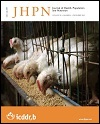Impact of Janani Suraksha Yojana on Institutional Delivery Rate and Maternal Morbidity and Mortality: An Observational Study in India
DOI:
https://doi.org/10.3329/jhpn.v30i4.13416Keywords:
Conditional cash transfer, Institutional deliveries, Maternal mortality, Maternal survival, IndiaAbstract
The Government of India initiated a cash incentive schemeJanani Suraksha Yojana (JSY)to promote institutional deliveries with an aim to reduce maternal mortality ratio (MMR). An observational study was conducted in a tertiary-care hospital of Madhya Pradesh, India, before and after implementation of JSY, with a sample of women presenting for institutional delivery. The objectives of this study were to: (i) determine the total number of institutional deliveries before and after implementation of JSY, (ii) determine the MMR, and (iii) compare factors associated with maternal mortality and morbidity. The data were analyzed for two years before implementation of JSY (2003-2005) and compared with two years following implementation of JSY (2005-2007). Overall, institutional deliveries increased by 42.6% after implementation, including those among rural, illiterate and primary-literate persons of lower socioeconomic strata. The main causes of maternal mortality were eclampsia, pre-eclampsia and severe anaemia both before and after implementation of JSY. Anaemia was the most common morbidity factor observed in this study. Among those who had institutional deliveries, there were significant increases in cases of eclampsia, pre-eclampsia, polyhydramnios, oligohydramnios, antepartum haemorrhage (APH), postpartum haemorrhage (PPH), and malaria after implementation of JSY. The scheme appeared to increase institutional delivery by at-risk mothers, which has the potential to reduce maternal morbidity and mortality, improve child survival, and ensure equity in maternal healthcare in India. The lessons from this study and other available sources should be utilized to improve the performance and implementation of JSY scheme in India.
DOI: http://dx.doi.org/10.3329/jhpn.v30i4.13416
J HEALTH POPUL NUTR 2012 Dec;30(4):464-471
Downloads
783
375

